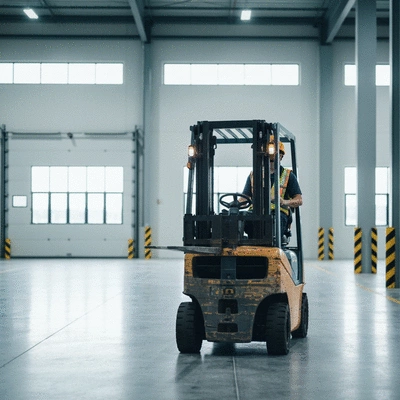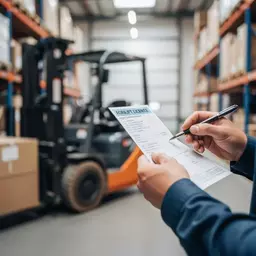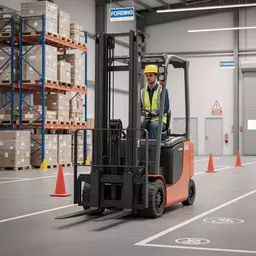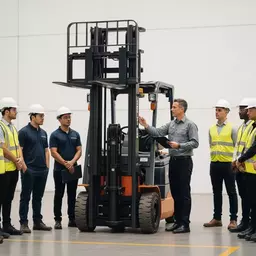Are you prepared to elevate your forklift operation skills and ensure safety in the workplace? Understanding forklift licences is essential for not only compliance but also for empowering your career in an evolving industry.
What You Will Learn
- Forklift licences are crucial for workplace safety and compliance, minimizing risks for operators and coworkers.
- Different types of forklifts serve specific functions, and understanding these can enhance operational efficiency.
- Familiarity with Australian safety standards (like AS 2359 and AS 4084) is essential for safe forklift operation.
- The LF licence allows broader operational scope compared to the LO licence, impacting job opportunities in the industry.
LF vs. LO Forklift Licences: Key Differences and Career Impact
This comparison highlights the distinctions between LF (Forklift) and LO (Order Picking Forklift) licences, outlining their operational scope, safety requirements, and career opportunities. Understanding the differences between LF and LO forklift licence requirements is crucial for aspiring operators.
LF Licence (Forklift)
-
✓
Types of Forklifts: Covers various forklift types, including counterbalance and reach forklifts.
-
✓
Operational Scope: Operators can work in multiple sectors, including construction and warehousing.
-
✓
Safety Requirements: May encounter more diverse compliance situations due to broader operational scope.
-
✓
Career Opportunities: Opens more doors in the job market, offering greater versatility.
LO Licence (Order Picking Forklift)
-
✓
Types of Forklifts: Limited specifically to order picking forklifts.
-
✓
Operational Scope: Typically used in warehouse settings for order picking.
-
✓
Safety Requirements: Adherence to safety protocols specific to order picking operations.
-
✓
Career Opportunities: More focused career path within warehouse and logistics roles.
Understanding Forklift Licences in Australia
Forklift licences are more than just a piece of paper; they are essential for ensuring workplace safety and compliance across various industries in Australia. With the rise of e-commerce and logistics, the demand for skilled forklift operators has increased significantly. Understanding the importance of obtaining your forklift licence is crucial for anyone looking to operate this machinery safely and effectively!
Whether you're new to the industry or looking to upgrade your skills, knowing the ins and outs of forklift licensing can empower you to make informed decisions. It also ensures that you're prepared for the challenges of operating forklifts in different environments. For more detailed guidance, consider consulting a comprehensive forklift licence training guide for Australia.

Importance of Forklift Licensing for Safety and Compliance
One of the primary reasons for forklift licensing is to promote safety in the workplace. Untrained operators pose a significant risk not only to themselves but also to their colleagues. When you obtain a forklift licence, you're committing to understanding the safety protocols and responsibilities that come with operating heavy machinery.
- Reduces workplace accidents and injuries
- Ensures compliance with legal requirements
- Enhances operational efficiency and productivity
Licensing also provides you with the confidence to handle forklifts safely. You'll learn about load capacity, stability, and the best practices for maneuvering in tight spaces, all of which are vital for minimizing risks.
Overview of Different Forklift Types and Their Uses
There are several types of forklifts, each designed for specific tasks and environments. Understanding the different forklift types and their uses is essential for anyone entering the industry. Here’s a quick overview:
- Counterbalance Forklifts: Ideal for general warehouse operations, these forklifts can lift, lower, and move loads in tight spaces.
- Reach Forklifts: Designed for high-lift operations, they are perfect for warehouses with narrow aisles.
- Pallet Jacks: Used for moving pallets short distances, these are essential in retail and warehousing.
Each type of forklift has its unique features and capabilities, which makes it crucial to choose the right one for the job. Training and licensing ensure that operators are well-equipped to handle the specific challenges associated with each type.
Australian Standards for Forklift Operation and Safety
In Australia, forklift operation and safety standards are governed by regulations that ensure the safe use of these machines in various settings. The Australian Standards serve as guidelines for training, maintenance, and operation. Familiarizing yourself with these standards is a fundamental part of the licensing process.
- AS 2359: This standard covers the safety requirements for forklifts.
- AS 4084: This standard pertains to the design and use of pallet racking systems.
- Compliance with these standards is mandatory for all operators.
Understanding these regulations is not only a requirement for obtaining your forklift licence but also a critical aspect of ensuring safety in the workplace. It’s all about creating a culture of safety, which is something we deeply emphasize at Forklift Licence Insights! For more information on maintaining a safe work environment, refer to forklift safety rules for operators.
We Want to Hear From You!
As you consider your journey towards obtaining a forklift licence, we’d love to know what factors are most important to you. Is it the type of forklift you want to operate, the training course options available, or perhaps the career opportunities that lie ahead? Share your thoughts with us below:
Summary of Forklift Licences and Their Significance
As we wrap up our discussion on forklift licences, it's essential to highlight the key differences between the LF and LO licences. These distinctions not only affect the types of forklifts you can operate but also influence your career opportunities and safety compliance requirements. Understanding these differences is crucial for anyone considering a career in the forklift industry.
The LF licence allows you to operate a broader range of forklifts, including counterbalance and reach forklifts. In contrast, the LO licence is specific to order picking forklifts, which are designed primarily for warehouse operations. This means that while both licences are vital, they cater to different operational environments and job functions.
Recap of Key Differences between LF and LO Licences
- Types of Forklifts: LF covers various forklift types, while LO is limited to order picking forklifts.
- Operational Scope: LF operators can work in multiple sectors, including construction and warehousing. LO operators typically work in warehouse settings.
- Safety Requirements: Both licences require adherence to safety protocols, but LF holders may encounter more diverse compliance situations.
- Career Opportunities: Holding an LF licence can open more doors in the job market compared to an LO licence.
With these distinctions in mind, aspiring forklift operators can better assess which licence aligns with their career goals and the specific equipment they'll be using in their future roles.

Final Thoughts on Choosing the Right Forklift Licence for Your Career
Choosing the right forklift licence is a significant step in your professional journey! I often hear from students and operators who are unsure about which path to take. My advice? Consider where you see yourself working and the types of forklifts you’re most likely to operate in that environment. If you're looking for versatility, the LF licence might be the way to go. For those focused on warehouse operations, an LO licence could fit perfectly.
It's also important to think about the industry trends and demand in your area. The forklift industry is continually evolving, and understanding local requirements and job prospects can help guide your decision. Remember, investing in the right training and licence today will pave the way for a successful career tomorrow!
Next Steps for Aspiring Forklift Operators
How to Choose the Right Training Course for Your Needs
With a clearer understanding of forklift licences, you're now ready to take the next step—choosing the right training course! Assessing your needs involves looking at your preferred working environment and the specific licences you require.
- Research Local RTOs: Look for Registered Training Organisations in your area that offer reputable forklift training.
- Check Course Content: Ensure the course covers both theoretical and practical training components relevant to your desired licence.
- Instructor Experience: Look for trainers with industry experience to enhance your learning experience.
By following these steps, you can select a course that sets you up for success in your forklift operation journey!
Frequently Asked Questions about Forklift Licences
As you embark on your forklift training, you might have some questions! Here are a few frequently asked questions I encounter:
- Do I need a licence to operate a forklift? Yes, operating a forklift without a valid licence is illegal and poses safety risks.
- How long does it take to get my forklift licence? Training duration varies, but most courses can be completed within a week.
- Can I upgrade my licence later? Absolutely! You can upgrade from an LO to an LF licence by completing the necessary training and assessments.
- What are the main differences between an LF and LO licence? An LF licence covers a broader range of forklifts (like counterbalance and reach), suitable for diverse sectors, while an LO licence is specific to order picking forklifts, primarily used in warehouse settings.
- Why is forklift licensing important for workplace safety? Licensing ensures operators understand safety protocols, load capacities, and best practices, significantly reducing the risk of accidents and injuries.
- Are Australian Standards mandatory for forklift operation? Yes, compliance with Australian Standards like AS 2359 and AS 4084 is mandatory for all forklift operators to ensure safe usage and maintenance.
These FAQs can help clarify any uncertainties as you prepare for your licensing journey!
Understanding Forklift Regulations by State and Their Impact on Training
Finally, it's crucial to recognize that forklift regulations can vary significantly by state. Each state in Australia has its own regulations that dictate training and licensing requirements. Familiarizing yourself with these local regulations will not only help you stay compliant but will also inform your training decisions. Make sure you understand how your state's regulations may influence your training and operational procedures! Navigating forklift licence compliance laws is essential for all operators.
At Forklift Licence Insights, I am here to support you every step of the way. Whatever your questions may be, I'm just a click away. Let's get you started on your journey to becoming a skilled forklift operator!
Recap of Key Points
- Obtaining a forklift licence is crucial for ensuring workplace safety and compliance.
- Different types of forklifts include counterbalance, reach forklifts, and pallet jacks, each suited for specific tasks.
- Familiarity with Australian Standards (AS 2359 and AS 4084) is essential for safe operation and legal compliance.
- The LF licence enables operation of a broader range of forklifts, while the LO licence is specific to order picking forklifts.
- Choosing the right training course involves researching local RTOs, checking course content, and ensuring instructor experience.







